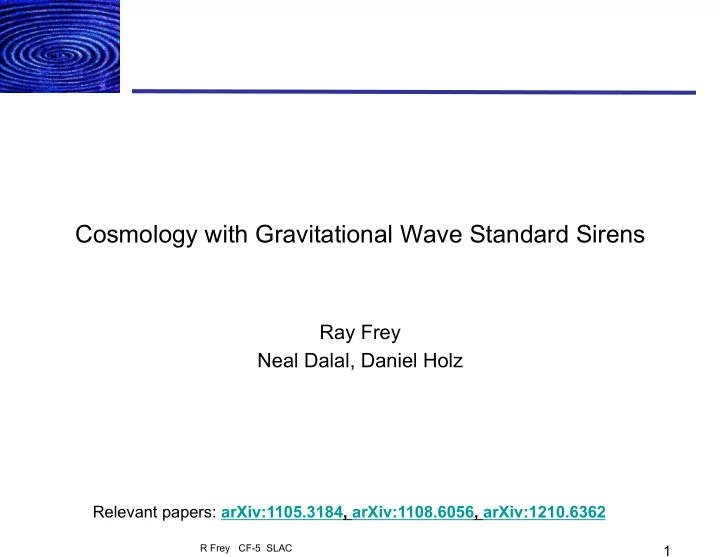

Cosmology with Gravitational Wave Standard Sirens Ray Frey Neal Dalal, Daniel Holz Relevant papers: arXiv:1105.3184, arXiv:1108.6056, arXiv:1210.6362 R Frey CF-5 SLAC 1
Standard Sirens • Measurement of GWs from inspiraling binaries (NS-NS, NS-BH, BH-BH) can provide absolutely calibrated distance (Schutz 1986) like SNIa, measures luminosity distance d L unlike SNIa, no calibration uncertainty. No distance ladder. d L is measured in Mpc (not h -1 Mpc). NO astrophysical systematics • Basic idea: from GWs, measure both : frequency chirp ⇒ total power in GW radiation strain h ij ⇒ infer GW flux at Earth • Ratio of luminosity/flux gives distance d L R Frey CF-5 SLAC 2
GW Detectors • Ground-based: LIGO: • 2 detectors, in Livingston LA and Hanford WA • upgrade to aLIGO : 2015 Virgo (France/Italy) KAGRA (Japan) LIGO-India? • Satellite: eLISA: ??? R Frey CF-5 SLAC 3
The 2 nd generation GW detector network Virgo GEO 2015 LIGO now Kagra 2015 ~2017 LIGO-India ~2019 R Frey CF-5 SLAC 4
Sources • ground-based GW detector networks (e.g. LIGO +Virgo+Kagra) are sensitive to nearby stellar mass BNS, NS-BH, BBH inspirals, z ≲ 0.2. too close to measure dark energy, but instead will constrain Hubble constant H 0 relevant frequencies: f ≈ 1-10 Hz to kHz, events are in band for ~ minutes • satellite missions (eLISA) probe supermassive black hole mergers out to high redshift (z ~ 2) relevant frequencies: f ≈ mHz, sources in band for ~ year R Frey CF-5 SLAC 5
Compact binary coalescence: expected rates arXiv: 1003.2480 , CQG, (LSC, Virgo) Short GRB rates consistent with this. But also uncertain (due to beaming angle) Fong and Berger, arXiv:1204.5475 R Frey CF-5 SLAC 6
Projected Advanced LIGO BNS Detection Rates aLIGO design by permission of G. Gonzalez, AAS 2013 3 rd AdvDet science run, 2017-18? 2 nd AdvDet science run, 2016-17? 1 st AdvDet science run, 2015? S5/S6 7 R Frey CF-5 SLAC
Limitations • Since GW emission is not isotropic, we need to know the inclination of orbital plane to measure distance can infer this from GW polarization – requires 2 or more non-aligned detectors (e.g. LIGO + (Virgo or Kagra or LIGO-India) Or infer from beaming for short GRBs due to binary mergers • Since GR is scale free, GW provide no redshift information we therefore require an independent measurement of redshift, from EM emission R Frey CF-5 SLAC 8
Distance forecasts • expect fractional errors on H 0 of ~ 0.05 (N/10) -1/2 for N Nissanke et al. (in prep) events, using 3-detector ground-based network • Number of detected events increases significantly as size of network increases • Smaller errors for eLISA sources. Noise is dominated by gravitational lensing H 0 (km/s/Mpc) A precision measurement of the Hubble constant,coupled with constraints at high redshift from the CMB, give a tremendous lever arm to measure properties of the dark energy equation of state. Measuring H0 removes a key uncertainty currently limiting our knowledge of the dark energy equation-of-state. R Frey CF-5 SLAC 9
DE Sensitivity To gauge the sensitivity to the DE EOS, Dalal et al calculated the error on H0 and w as a function of the number of BNS events. Assumptions: • 1% CMB Ω m h 2 • flat universe • w constant R Frey CF-5 SLAC 10
Role of precision H0 Weinberg, et al. 2012 • Precision H0 will aid other DE probes • FOM from DETF • From Weinberg et al. (2012): Assuming a w0 − w a model for dark energy, a 1% H0 measurement would raise the DETF Figure of Merit by 40% A precise determination of H0, coupled to a w(z) parameterization that allows low-redshift variation, could … definitively answer the basic question, “Is the universe still accelerating?” R Frey CF-5 SLAC 11
EM counterparts • Need redshifts to measure H0 • Requires independent observations of any EM emission • Two possibilities: independent trigger (e.g. GRB detection from all-sky γ - ray satellite) provides space-time coordinates for GW search follow-up of GW trigger • e.g. off-axis GRB afterglow or isotropic kilonova afterglow • Follow-up of GW sources requires good localization on the sky R Frey CF-5 SLAC 12
Localization NS-NS binary inspirals Fairhurst et al., arXiv:0908.2356; 1010.6192; 1205.6611 LIGO-Virgo LIGO-Virgo + LIGO India For 4-element networks expect ~ 10 deg 2 R Frey CF-5 SLAC 13
Identifying EM counterparts • EM follow-up (optical, X-ray, radio…) must tile the GW error box • However, we expect the EM flux to fade quickly (reach r>24 in ~ day) • need to cover error box quickly ⇒ need fast, wide- area imagers e.g. see analysis by Metzger & Berger arXiv:1108.6056 R Frey CF-5 SLAC 14
Wide-field imaging • This requires target-of-opportunity imaging on observatories with large etendue LSST obviously ideal. Reaches r ≈ 24.5 in 15 seconds over 9.6 deg 2 FOV, so it can cover error box within minutes but other wide-area imagers may be adequate, e.g. DECam reaches r ≈ 24.5 in < 2 minutes over 3 deg 2 FOV, so it can cover error box within hours. HSC even faster (and is in the North, so it’s complementary) BUT : we don’t know how faint the optical emission will be. If much fainter than GRB afterglows, then LSST ToO may be necessary. the broader the latitude & longitude coverage, the higher the fraction of events that are followed up R Frey CF-5 SLAC 15
Summary • GW measurements of compact binary mergers at low z … provide check of distance ladder with enough events provide precision H0 measurement which, when combined with other measurements, improves DE constraints • Requires independent observations of any EM emission Short GRB-triggered GW search GW-triggered EM followup • Expect the experimental program to bring results during the period 2015-2020 R Frey CF-5 SLAC 16
Recommend
More recommend